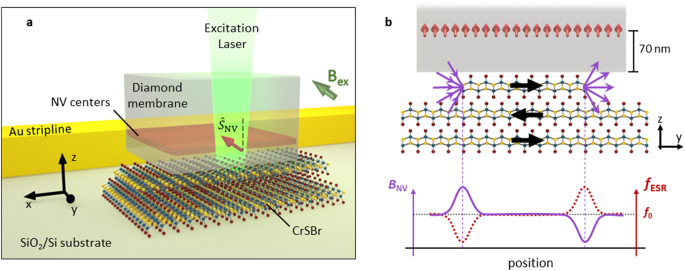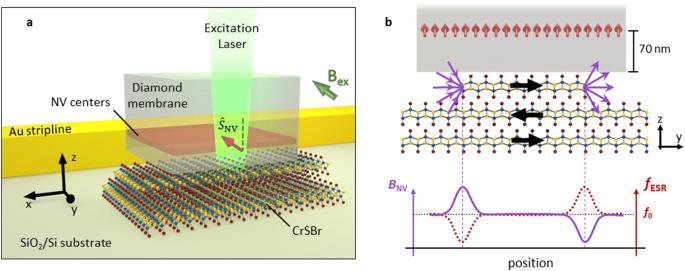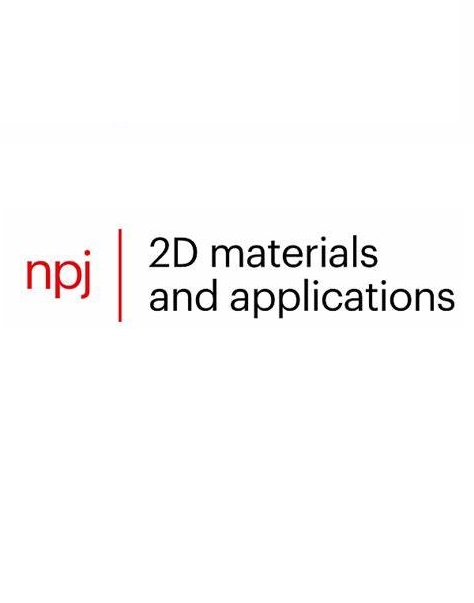Nitrogen-vacancy magnetometry of CrSBr by diamond membrane transfer
IF 9.1
2区 材料科学
Q1 MATERIALS SCIENCE, MULTIDISCIPLINARY
引用次数: 0
Abstract
Magnetic imaging using nitrogen-vacancy (NV) spins in diamonds is a powerful technique for acquiring quantitative information about sub-micron scale magnetic order. A major challenge for its application in the research on two-dimensional (2D) magnets is the positioning of the NV centers at a well-defined, nanoscale distance to the target material required for detecting the small magnetic fields generated by magnetic monolayers. Here, we develop a diamond “dry-transfer” technique akin to the state-of-the-art 2D-materials assembly methods and use it to place a diamond micro-membrane in direct contact with the 2D interlayer antiferromagnet CrSBr. We harness the resulting NV-sample proximity to spatially resolve the magnetic stray fields generated by the CrSBr, present only where the CrSBr thickness changes by an odd number of layers. From the magnetic stray field of a single uncompensated ferromagnetic layer in the CrSBr, we extract a monolayer magnetization of MCSB = 0.46(2) T, without the need for exfoliation of monolayer crystals or applying large external magnetic fields. The ability to deterministically place NV-ensemble sensors into contact with target materials and detect ferromagnetic monolayer magnetizations paves the way for quantitative analysis of a wide range of 2D magnets assembled on arbitrary target substrates.


金刚石膜转移法测定CrSBr的氮空位磁强计
利用金刚石中的氮空位(NV)自旋进行磁成像是一种获取亚微米级磁序定量信息的强大技术。将其应用于二维(2D)磁体研究的一个主要挑战是如何将氮空位中心定位在目标材料所需的明确纳米级距离上,以探测磁单层产生的小磁场。在这里,我们开发了一种类似于最先进的二维材料组装方法的金刚石 "干法转移 "技术,并利用它将金刚石微膜与二维层间反铁磁体 CrSBr 直接接触。 我们利用由此产生的 NV-样品接近度,从空间上解析了 CrSBr 产生的磁杂散场,这种磁杂散场只存在于 CrSBr 厚度变化为奇数层的地方。从 CrSBr 中单层未补偿铁磁层的磁杂散场中,我们提取出了 MCSB = 0.46(2) T 的单层磁化,而无需剥离单层晶体或施加大的外部磁场。将 NV-ensemble 传感器确定性地与目标材料接触并检测铁磁单层磁化的能力,为对组装在任意目标基底上的各种二维磁体进行定量分析铺平了道路。
本文章由计算机程序翻译,如有差异,请以英文原文为准。
求助全文
约1分钟内获得全文
求助全文
来源期刊

npj 2D Materials and Applications
Engineering-Mechanics of Materials
CiteScore
14.50
自引率
2.10%
发文量
80
审稿时长
15 weeks
期刊介绍:
npj 2D Materials and Applications publishes papers on the fundamental behavior, synthesis, properties and applications of existing and emerging 2D materials. By selecting papers with the potential for impact, the journal aims to facilitate the transfer of the research of 2D materials into wide-ranging applications.
 求助内容:
求助内容: 应助结果提醒方式:
应助结果提醒方式:


